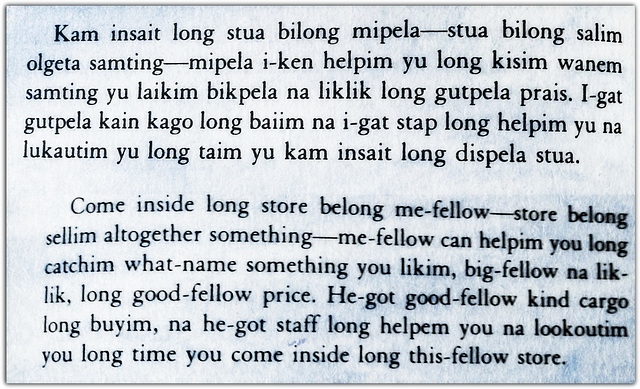Tulip
How English has changed over the last 1000 years
Mall of America
Mall of America
Mall of America
Mall of America
An Artist
"Ludul Bel Nemeqi" - I will praise the Lord of Wis…
Ukulele player
Minihaha Falls
Hammered Dulcimer (Santoor)
Minneapolis
Minneapolis
Size of a carbon atom
Snow White's visit
Photographer
Gladious
Farmers Market
Farmers Market
Farmers Market
Egg currey
Paul Berg
Sugar Bush trail
Riverwood Park
Aloof
Ford 1951
A Ford
Flexing
Spider flower
Wendy - a portrait
Amanda - a portrait
Red winged blackbird
Buddha
Unadmired
Daisies
Ford
Chase
Iris *
Abandoned
Wet leaf
Alpha
He likes bread and butter
Keywords
Authorizations, license
-
Visible by: Everyone -
All rights reserved
- Photo replaced on 23 Sep 2013
-
137 visits
Neo-Melanesian/Neo-Melanesian English Ad


The Ad Means:
Come into our store – a store for selling everything – we can help you get whatever you want, big and small, at a good price. there are good types of goods for sale, and staff to help you and look after you when you visit the store.
Come into our store – a store for selling everything – we can help you get whatever you want, big and small, at a good price. there are good types of goods for sale, and staff to help you and look after you when you visit the store.
- Keyboard shortcuts:
Jump to top
RSS feed- Latest comments - Subscribe to the comment feeds of this photo
- ipernity © 2007-2024
- Help & Contact
|
Club news
|
About ipernity
|
History |
ipernity Club & Prices |
Guide of good conduct
Donate | Group guidelines | Privacy policy | Terms of use | Statutes | In memoria -
Facebook
Twitter

When I arrived in Papua New Guinea and first heard Neo-Melanesian, I was scornful of it. It sounded like long winded, grammarless baby talk, I was jolted to discover that New Guineans weren’t understanding me. My assumption that Neo-Melanesian words meant the same as their English cognates led to spectacular disaster…….
Neo-Melanesian proved to be as strict as English in its grammatical rules. It is supple language that lets one express anything sayable in English. It even lets one make some distinctions that cannot be expressed in English except by means of clumsy circumlocutions. For example, the English pronoun “we” actually lu8mps two quite different concepts: “I plus you to whom I am speaking,” and “I plus one or more other people, but not including you to whom I am speaking. In Neo-Melanesian these two separate meanings are expressed by the words “yumi” and “mipela,” respectively. ….
Neo-Melanesian’s deceptive simplicity and actual suppleness stem partly from its vocabulary, partly from its grammar. Its vocabulary is based on a modest number of core words whose meaning varies with context and becomes extended metaphorically. For instance, while Neo-Melanesian “gras” can mean English “grass (whence “gras bilong solwara [salt water] “ means “seaweed”), it also can mean “hair,” whence “man I no gat grass long head bilong em” becomes “bald man.”
…… It is a normal complex language in its hierarchical organization of phonemes, syllables, and words. It lends itself so well to hierarchical organization of phases, and sentence that election speeches by New Guinea politicians rival the German prose of Thomas Mann in their convoluted structure.
Out of the temporary linguistic chaos that followed the ‘plantations or forts’ founding, simplified but stabilized new languages emerged. Consider the evolution of Neo-Melanesian as an example. After English ships began to visit Melanesian islands just east of New Guinea around 1820, the English also took islanders to work on the sugar plantations of Queensland and Samoa, where workers of many language groups were thrown together. From this Babel sprang somehow the Neo-Melanesian language, whose vocabulary is 80 percent English, 15 percent Tolai (the Melanesian group that furnished many of the workers) and the rest Malay and other languages. ~ Excerpt from Pages 157 to 159
Sign-in to write a comment.